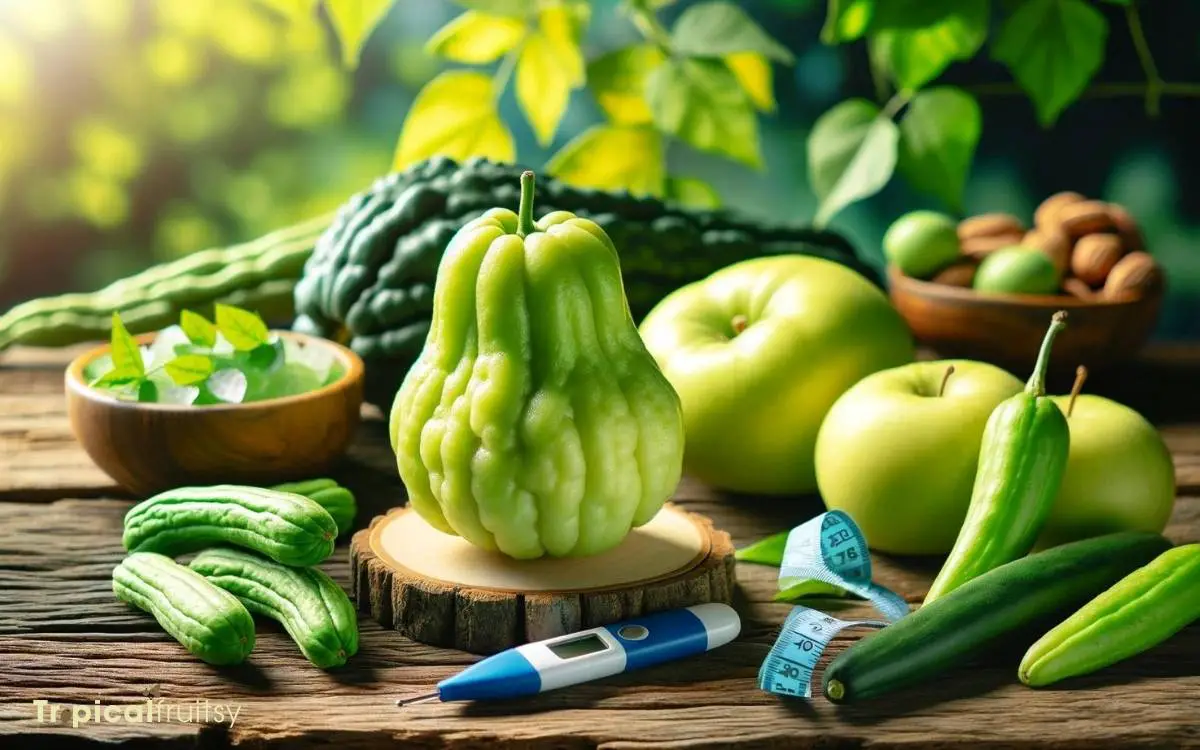Is Chayote Bad for Diabetes? Unveiling the Truth!
No, chayote is not bad for diabetes; in fact, it is a healthy addition to a diabetic diet due to its low carbohydrate content and beneficial nutrients.
Chayote, also known as mirliton squash or vegetable pear, is a low-starch fruit often treated as a vegetable in culinary contexts.
It’s an excellent food choice for individuals managing diabetes for several reasons:
Individuals with diabetes can benefit from including chayote in their diets in various forms, such as raw in salads, steamed, or sautéed.
Incorporating chayote into a diabetic diet offers a tasty way to enjoy a variety of nutrients without significantly impacting blood sugar levels.

Key Takeaway
Understanding Chayote
Chayote, a single-seeded berry native to Mesoamerica, belongs to the gourd family Cucurbitaceae and is known for its versatility and nutrient-rich profile.
Often consumed as a vegetable, it is low in calories but high in fiber, which is beneficial for digestion and may aid in the management of blood sugar levels, a crucial factor for individuals with diabetes.
The presence of antioxidants, vitamins, and minerals like vitamin C, folate, and zinc contribute to overall health and can support the immune system.
For patients seeking dietary options that can help control diabetes, chayote represents a wholesome choice.
Incorporating this food into a balanced diet can offer variety while aligning with health goals, especially for those monitoring carbohydrate intake.
Nutritional Profile Breakdown
When considering the suitability of chayote for individuals managing diabetes, a detailed examination of its nutritional profile is essential.
Key components to focus on include its low caloric content, which can aid in weight management, and its fiber content, which is known to have a positive impact on blood sugar levels.
Additionally, understanding the glycemic index value of chayote will offer insight into how it may affect blood glucose control after consumption.
Low Caloric Content
Regarding the nutritional profile of chayote, one of its key features is its remarkably low caloric content, which can be particularly beneficial for individuals managing diabetes.
A standard serving of chayote, which is approximately one cup, contains only about 25 calories.
This minimal caloric impact makes it an excellent choice for those who are monitoring their energy intake, especially since managing body weight is often an important aspect of diabetes care.
The low calorie count also allows for greater flexibility in diet planning, as chayote can be included in meals without significantly increasing total caloric intake.
Transitioning to the analysis of another nutritional aspect, the fiber content of chayote deserves attention for its role in diabetes management.
Fiber Content Analysis
The fiber profile of chayote complements its low caloric value by offering additional benefits for blood sugar regulation, a crucial factor in diabetes management.
Dietary fiber is known to slow the absorption of sugar, helping to control blood glucose levels. For individuals with diabetes, consuming foods with adequate fiber is an essential part of the dietary strategy to manage their condition.
| Nutrient | Amount per 100g | % Daily Value* |
|---|---|---|
| Total Calories | 19 | <1% |
| Total Fiber | 1.7g | 7% |
| Soluble Fiber | 0.85g | Not Specified |
| Insoluble Fiber | 0.85g | Not Specified |
Percent Daily Values are based on a 2,000 calorie diet. Actual daily values may vary based on individual needs. Chayote’s fiber content, although not as high as some other vegetables, is a valuable component of a balanced diet, particularly for those managing diabetes.
Glycemic Index Value
Continuing the examination of chayote’s suitability for individuals with diabetes, its glycemic index value merits particular attention as a low-ranking number, indicative of its minimal impact on blood sugar levels.
The glycemic index (GI) is a numerical system that measures how much certain foods increase blood glucose levels. A low GI value is especially beneficial for managing diabetes, and chayote’s nutritional profile is supportive of this need.
Consider the following aspects of chayote’s GI value:
- Chayote has a low glycemic index, typically well below 55, which classifies it as a low-GI food.
- Its carbohydrate content is slowly digested and absorbed, resulting in a gradual rise in blood glucose.
- Including chayote in a meal can contribute to a lower overall glycemic load.
- Chayote’s low GI value supports stable blood sugar control, an essential aspect of diabetes management.
Chayote and Blood Sugar
Chayote, a low-glycemic vegetable, may contribute to stable blood sugar levels in individuals with diabetes.
The consumption of lower glycemic foods is crucial in managing the glycemic response and thereby aids in the regulation of blood sugar.
Chayote’s fibrous content can slow down the absorption of glucose, preventing spikes in blood sugar levels and providing a stable energy source.
| Benefit | Emotion | Impact on Diabetes |
|---|---|---|
| Low Glycemic Load | Reassurance | Stable Blood Sugar |
| High in Fiber | Satisfaction | Controlled Absorption |
| Nutrient-Rich | Optimism | Improved Well-being |
Understanding the relationship between food intake and blood sugar control is essential for those managing diabetes.
By incorporating chayote into their diet, individuals may find a heartening ally in the daily effort to balance nutrition and health.
Benefits for Diabetes Management
Chayote, a low-glycemic index food, may be a beneficial addition to a diabetic diet by offering a slower, more stable release of glucose into the bloodstream.
Its high fiber content is instrumental in promoting satiety and aiding in the management of blood sugar levels.
Furthermore, the inclusion of chayote in meals can assist in the overall regulation of blood sugar, which is a critical aspect of diabetes management.
Low Glycemic Index
Within the context of diabetes management, the low glycemic index of chayote is a significant benefit for individuals seeking to control blood sugar levels. The glycemic index (GI) is a ranking of how much certain foods raise blood glucose.
Foods with a low GI, like chayote, can help maintain more stable blood sugar levels, which is crucial for diabetes care.
- Stabilizes Blood Sugar: Low-GI foods like chayote cause a slower, more gradual rise in blood sugar levels, reducing the risk of spikes.
- Enhances Satiety: Chayote can increase feelings of fullness, which may prevent overeating and support weight management.
- Improves Insulin Sensitivity: Regular consumption of low-GI foods can help improve insulin sensitivity over time.
- Reduces Hypoglycemia Risk: Eating chayote may decrease the likelihood of blood sugar drops that lead to hypoglycemia.
High Fiber Content
In addition to its low glycemic index, the high fiber content of chayote offers further advantages for diabetes management, aiding in blood sugar control and digestive health.
Fiber is crucial for the diabetic diet because it can slow the absorption of sugar, helping to prevent spikes in blood glucose levels.
Chayote’s fiber can also promote satiety, which may assist in weight management, an important aspect of managing diabetes.
| Nutrient | Benefit for Diabetes Management |
|---|---|
| Soluble Fiber | Helps to regulate blood sugar levels |
| Insoluble Fiber | Aids in digestive health and regularity |
| Total Fiber | Contributes to satiety and weight control |
| Glycemic Load | Low impact on blood sugar spikes |
Understanding the fiber profile of chayote is beneficial for individuals looking to tailor their dietary intake for optimal diabetes control.
Blood Sugar Regulation
Stability in blood glucose levels is a primary benefit of including chayote in a diabetes management plan.
This green vegetable may offer several advantages for individuals aiming to control their blood sugar:
- Low Glycemic Index: Chayote has a low glycemic index (GI), meaning it causes a slower rise in blood glucose levels.
- Fiber Content: The fiber in chayote slows carbohydrate digestion, aiding in gradual sugar absorption.
- Insulin Sensitivity: Regular consumption of chayote might improve insulin sensitivity, facilitating better blood sugar control.
- Nutrient-Rich: Chayote is high in vitamins and minerals that are essential for overall metabolic health, which can indirectly support blood sugar regulation.
These characteristics make chayote a potentially beneficial food for those managing diabetes, contributing to a balanced diet and stable blood sugar levels.
Potential Risks and Considerations
Despite its low glycemic index, individuals with diabetes must consider the potential for allergic reactions when incorporating chayote into their diet.
While chayote is generally safe for consumption, allergies, although rare, can occur. Symptoms may include itching, swelling, and difficulty breathing, which require immediate medical attention.
Moreover, patients taking hypoglycemic medications should monitor their blood sugar levels closely as chayote’s blood sugar-lowering effects could potentially enhance their medication’s impact, leading to hypoglycemia.
It is also essential for individuals with diabetes to consider the overall balance of their diet.
Chayote should be integrated into a meal plan that includes a variety of nutrients necessary for optimal health.
Consulting with a healthcare provider or a registered dietitian can help ensure that chayote is a beneficial addition to a diabetes-friendly diet.
Cooking Tips for Diabetics
Diabetics seeking to include chayote in their meals can benefit from cooking methods that preserve its low glycemic properties and enhance its flavor.
Here are four practical cooking tips:
- Steam or Boil: Steaming or boiling chayote preserves its nutrients and maintains a low glycemic index, helping to regulate blood sugar levels.
- Use Healthy Fats: When sautéing, opt for olive oil or other healthy fats. These fats do not impact the glycemic index and can help with the absorption of fat-soluble vitamins.
- Incorporate Herbs and Spices: Season with fresh herbs and spices instead of salt or sugar to add flavor without affecting blood sugar.
- Avoid High-Heat Cooking: High temperatures can break down the beneficial compounds in chayote. Cook gently to retain its health properties.
Making an Informed Decision
When considering the inclusion of chayote in a diabetic diet, patients must evaluate its nutritional content and potential impact on blood sugar management.
Known for its low calorie and high fiber content, chayote can be a nutritious addition that may aid in glycemic control.
The fiber in chayote slows down the absorption of sugars, which can prevent rapid spikes in blood glucose levels, a critical aspect for individuals managing diabetes.
However, it is essential for patients to consult with healthcare providers to tailor their dietary choices to their specific health needs.
By analyzing the glycemic index of chayote and monitoring blood sugar responses, patients can make informed decisions that support their overall diabetes management plan, ensuring they maintain optimal blood sugar levels and overall health.
Conclusion
Chayote is a favorable option for individuals managing diabetes, offering a low glycemic index and rich nutritional profile.
The consumption of chayote can contribute to blood sugar regulation, owing to its fiber content and minimal impact on glucose levels.
However, awareness of potential risks and appropriate preparation methods is essential. Incorporating chayote into a diabetic diet, with consideration of individual health factors, can be beneficial if done under professional guidance.






